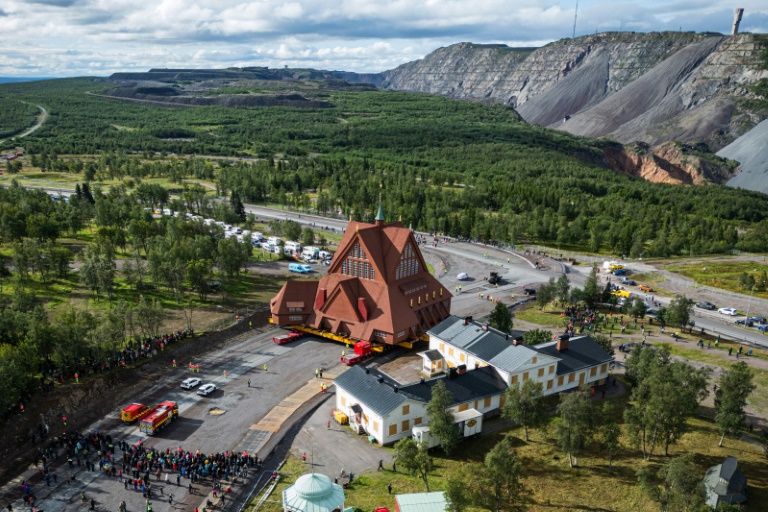World
Historic Kiruna Church Moves to New Location Amid Mine Expansion

A historic red wooden church in Kiruna, Sweden, is on the move as it transitions to a new location to accommodate the expansion of Europe’s largest underground iron ore mine. The relocation of the Kiruna Kyrka, a Swedish Lutheran church built in 1912, resumed on Wednesday, continuing a complex operation that began on Tuesday. The church is being transported five kilometres (three miles) on remote-controlled flatbed trailers, moving at a slow pace of half a kilometre per hour.
The entire town centre of Kiruna is undergoing relocation due to the ongoing expansion of the LKAB iron ore mine, which has caused ground instability that poses a risk of collapse in certain areas. The church, weighing 672 tonnes, represents a significant cultural landmark and its move is part of a broader effort to shift the entire town, a process that has been in development for nearly two decades. The new town centre was officially inaugurated in September 2022.
As the church’s convoy made its way through Kiruna, large crowds gathered to witness the journey, with Swedish television broadcasting the event live. The relocation has generated considerable interest, and King Carl XVI Gustaf is scheduled to participate in festivities celebrating the move. These events include an attempt to break the world record for the most attendees at a traditional “kyrkkaffe”—a church coffee break.
The logistics involved in moving Kiruna Kyrka are intricate and costly. The total expenditure for the church’s relocation is expected to reach 500 million kronor (approximately $52 million), with funding provided by LKAB. Designed by architect Gustaf Wickman, the church features a blend of architectural styles, including neo-Gothic elements and designs inspired by the Indigenous Sami people, particularly evident in the church pews.
The church stands 40 metres (131 feet) tall and boasts a striking exterior with slanting roofs and windows. Inside, the design incorporates aspects of national romanticism, highlighted by an Art Nouveau altarpiece and a grand organ with over 2,000 pipes. Prior to the move, the church’s handblown glass windows were removed and temporarily replaced with plywood painted to resemble windows.
Officials indicated that the move, which includes navigating narrow passages and making tight turns, might progress at a slower rate on Wednesday due to these challenges. The belltower, previously situated next to the church, is scheduled to be moved next week.
This significant operation not only reflects Kiruna’s adaptation to the demands of industry but also underscores the town’s commitment to preserving its cultural heritage amidst change. The relocation of Kiruna Kyrka serves as a poignant reminder of the balance between progress and tradition in a rapidly evolving landscape.
-

 Science3 months ago
Science3 months agoToyoake City Proposes Daily Two-Hour Smartphone Use Limit
-

 Top Stories3 months ago
Top Stories3 months agoPedestrian Fatally Injured in Esquimalt Collision on August 14
-

 Health3 months ago
Health3 months agoB.C. Review Reveals Urgent Need for Rare-Disease Drug Reforms
-

 Technology3 months ago
Technology3 months agoDark Adventure Game “Bye Sweet Carole” Set for October Release
-

 World3 months ago
World3 months agoJimmy Lai’s Defense Challenges Charges Under National Security Law
-

 Lifestyle3 months ago
Lifestyle3 months agoVictoria’s Pop-Up Shop Shines Light on B.C.’s Wolf Cull
-

 Technology3 months ago
Technology3 months agoKonami Revives Iconic Metal Gear Solid Delta Ahead of Release
-

 Technology3 months ago
Technology3 months agoApple Expands Self-Service Repair Program to Canada
-

 Technology3 months ago
Technology3 months agoSnapmaker U1 Color 3D Printer Redefines Speed and Sustainability
-

 Technology3 months ago
Technology3 months agoAION Folding Knife: Redefining EDC Design with Premium Materials
-

 Business3 months ago
Business3 months agoGordon Murray Automotive Unveils S1 LM and Le Mans GTR at Monterey
-

 Technology3 months ago
Technology3 months agoSolve Today’s Wordle Challenge: Hints and Answer for August 19









